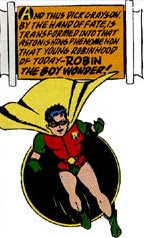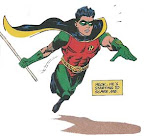Dressing Like a Stoplight to Sneak Around at Night
 My last weekly Robin posting quoted Batman artists Neal Adams and Norm Breyfogle agreeing in 1990 on how it didn't make any sense for Robin's costume to leave his legs bare. They also agreed on another impractical aspect of the character's original uniform, designed by Jerry Robinson fifty years earlier.
My last weekly Robin posting quoted Batman artists Neal Adams and Norm Breyfogle agreeing in 1990 on how it didn't make any sense for Robin's costume to leave his legs bare. They also agreed on another impractical aspect of the character's original uniform, designed by Jerry Robinson fifty years earlier.
Adams:
His colors were too bright — yellow and red — and he was going to be out at night, it doesn’t make any sense.Breyfogle:
Too bright; Robin is living target; yellow cape with yellow color is main problem.Originally, Robin's costume didn't need to be so practical. An early superhero costume was basically symbolic, and in Robin's case the design signaled that he was a boy from a circus.
Just as important, Robin's uniform offered a visual contrast to Batman's, providing more sensation for readers' eyes and making it easy to distinguish the two characters. The printing presses of the time didn't offer comic-book artists a wide range of colors. Since Batman's costume was already being depicted in black, gray, and blue, Robin apparently got his choice of the remaining tints. He took nearly all of them: red, green, and yellow.
 Again, this costuming operated more on a symbolic level than as a reflection of life. The artists often used the same color contrast to distinguish Batman and Robin's civilian identities. The first decade of Batman comics would show Bruce Wayne in a blue suit or dressing-gown. Dick Grayson would wear the same eye-popping color combination during the daytime as at night. That meant readers rarely missed where Dick/Robin was in a scene.
Again, this costuming operated more on a symbolic level than as a reflection of life. The artists often used the same color contrast to distinguish Batman and Robin's civilian identities. The first decade of Batman comics would show Bruce Wayne in a blue suit or dressing-gown. Dick Grayson would wear the same eye-popping color combination during the daytime as at night. That meant readers rarely missed where Dick/Robin was in a scene.By the 1980s, however, superhero philosophes had started to question why a teenager who was supposed to be sneaking around dangerous places at night would wear a bright yellow cape. Yet the character of Robin had been established--and lucratively licensed--for almost half a century. Changing his costume too much could jeopardize that trademark.
It's interesting that both Adams and Breyfogle came up with the same way of providing the Robin costume with a concealing dark exterior while keeping some yellow around his shoulders: a dark cape (or wings, or collar) with a yellow lining. There's no crime-fighting reason for the bright lining, but without it Robin wouldn't be Robin.
 Adams's redesign, which DC eventually adopted, also emphasized various forms of protective fabrics, body armor, and built-in tools and electronics. The new, longer cape was said to be made of Nomex and Kevlar with an armored collar, and it had pockets and a quick-release button and goodness knows what else. DC had no choice but to keep the cape, after all--though how all that weight could flap so dramatically is best left unexamined.
Adams's redesign, which DC eventually adopted, also emphasized various forms of protective fabrics, body armor, and built-in tools and electronics. The new, longer cape was said to be made of Nomex and Kevlar with an armored collar, and it had pockets and a quick-release button and goodness knows what else. DC had no choice but to keep the cape, after all--though how all that weight could flap so dramatically is best left unexamined.Even with the new cape, however, the redesigned Robin was still known for wearing that eye-popping combination of red and green.



4 comments:
By coincidence, scans_daily just included a link that ultimately led to this take on the Robin costume. Cosplay via Photoshop, I suppose.
This competition offers some other examples worth checking out.
There is an alternative theory to explain why Robin's costume is so bright. I believe Tim Drake has even discussed it with Bruce Wayne, who quickly assured him it has no basis in reality. Uh-huh.
"Yet the character of Robin had been established--and lucratively licensed--for almost half a century".
Very few tie-in merchandise items preceded the 1966 TV show, as Chip Kidd pointed out in a guide to collectibles. Otherwise, helpful articles.
There was definitely an explosion of licensed toys and other collectibles in the 1960s. But DC also made money from the Robin character as costumed through the 1940s comic strip and movie serials. I read of lead figurines of Batman and Robin given out at carnivals in the same period, but it’s not clear to me whether anyone was paying DC to make them.
Post a Comment